ファイバー出力タングステンハロゲンランプ光源
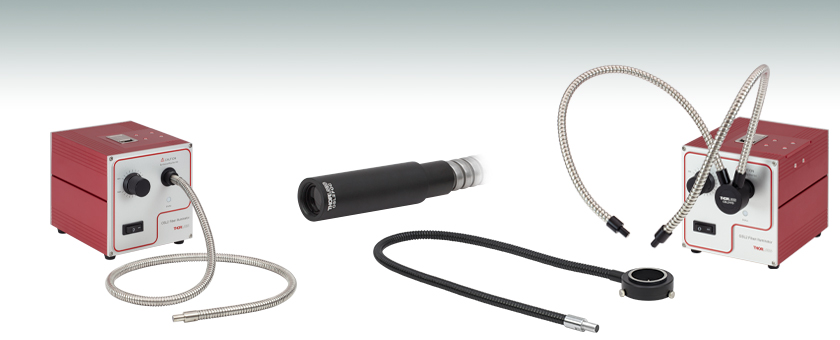
- 150 W High-Output Halogen Lamps with Variable Intensity Control
- 91 cm (36") Long Fiber Bundle Included
- Optional Accessories Include Gooseneck Fiber Bundles,
Microscope Ring Illuminator, and Collimation Packages
OSL2COL
Collimation Package (Shown Attached to OSL2YFB Fiber Bundle)
FRI61F50
Microscope Ring Illuminator
Application Idea
OSL2YFB Gooseneck Y-Bundle with the OSL2 Light Source
High-Intensity Fiber-Coupled Illuminator, Fiber Bundle Included
OSL2

Please Wait
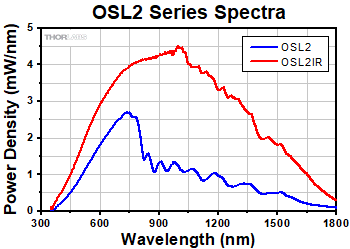
Click to Enlarge
生データはこちらからダウンロードいただけます。
光源OSL2のライトバルブOSL2B(青色)とOSL2IRのライトバルブOSL2BIR(赤色)出力のスペクトルです。ライトバルブOSL2Bにはホットミラーが内蔵されていて、ほとんどの赤外域光をブロックします。ライトバルブOSL2BIRには赤外域で出力が強化されるためのアルミニウムコーティング付きのリフレクタが付いています。スペクトル取得には付属のファイバーバンドルが使用されており、この結果にはファイバでの減衰が考慮されます。
特長
- 高出力150 Wバルブ、色温度3200 K
- OSL2:ほとんどの赤外域光をブロックするホットミラーとライトバルブOSL2Bが内蔵
- OSL2IR:赤外域での出力を強化するアルミニウムコーティング付きリフレクタとライトバルブOSL2BIRが内蔵
- DC結合電源により安定した出力光を実現
- 前面パネルのノブで強度の調整が可能(0%~100%)
- 堅牢な設計、サーマルセーフティーカットオフ付き
- 長さ91 cm、コア径Ø6.4 mmのファイバーバンドルが付属
- SM1内ネジ付き出力ポート
高強度ファイバ出力光源OSL2およびOSL2IRは、明視野顕微鏡や研究用、また照明用に白色光を放射します。ユニット前面のノブにより、出力される照明強度が0~100%の範囲で指数関数的に変えられます。150 W EKEハロゲンバルブの色温度は3200 Kで(右のグラフをご覧ください)、ご自身で下記のバルブと交換可能です。このファイバ出力光源は、100~120 VACならびに220~240 VACに対応可能で、日本国内仕様の電源コードが付属します。
光源OSL2とOSL2IRには長さ91 cm、有効コア径Ø6.4 mmのファイバーバンドルが付属します。 ファイバーバンドルをオプトメカニクスのセットアップに取り付けるには、マウント用アダプタAD8Fのご使用をお勧めします(左の写真参照)。アダプタにはSM1外ネジが付いているので当社のSM1ネジ付き部品への取り付けが簡単です。特にこちらのアダプタは、OSL2またはOSL2IRをCerna®顕微鏡に接続し、落射照明ならびに透過照明の両方にお使いいただけます。詳細は「Cernaでの使用」のタブをご覧ください。
ファイバ照明用の出力ポートには長さ3.5 mmのSM1内ネジも付いています。発送時、このポートにはファイバーバンドル接続用アダプタが付いています。 このアダプタを出力ポートから外すと、標準的なファイバ接続用アダプタ(下記参照)ほかSM1ネジ付き部品を光源に取り付けることができます。
アクセサリ
当社では、ファイバーバンドル端に取り付けるコリメート用ならびに集光用パッケージ、単一出力のファイバーバンドル、2本のグースネック型アームが付いたY分岐ファイバーバンドル、ならびに顕微鏡リングイルミネータをご用意しております。 単一出力型ファイバーバンドルには2種類ございます。付属品の交換用としての金属被覆のバンドルと、剛性を持たせて手動で容易に位置決めができるグースネック型バンドルです。 さらに長いファイバーバンドルはカスタムオーダとして承ります。詳細は当社までお問い合わせください。
高強度ファイバ光源の交換用ライトバルブは4種類ご用意しております。発光スペクトルの情報を含めて下記をご覧ください。 OSL2BはOSL2に、OSL1Bは旧タイプのOSL1にそれぞれ内蔵されていたものと同じバルブで、可視スペクトル域で発光します。 OSL2B2も可視スペクトル域で発光しますが、出力パワーが高いかわりに寿命は短くなります。 そしてOSL2BIRは、OSL2IRに使用しますが、アルミニウムコーティングのリフクレクタを使用することにより、近赤外域における光量を高めています。 対応バルブの詳細については「仕様」タブもご覧ください。
より高い色温度をご希望の場合には、色温度調整フィルタを使用し、光源OSL2からの青色の光を透過させながら赤色の光を減衰させることができます。 その結果として、より高い色温度が得られますが、出力パワーは低下します。

Click to Enlarge
生データはこちらからダウンロードいただけます。
光源OSL2のライトバルブOSL2B(青色)とOSL2IRのライトバルブOSL2BIR(赤色)出力のスペクトルです。ライトバルブOSL2Bにはホットミラーが内蔵されていて、ほとんどの赤外域光をブロックします。ライトバルブOSL2BIRには赤外域で出力が強化されるためのアルミニウムコーティング付きのリフレクタが付いています。スペクトル取得には付属のファイバーバンドルが使用されていますが、この結果にはファイバでの減衰は含まれていません。
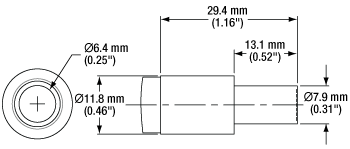
Click to Enlarge
付属のファイバーバンドル出力端
| Item # | OSL2a | OSL2IRa |
|---|---|---|
| Light Source Specs | ||
| Power at Fiber Tip | 1.4 W at Maximum Bulb Intensity | 3.8 W at Maximum Bulb Intensity |
| Color Temperature of Included Bulb | 3200 K at Maximum Bulb Intensity | |
| Operating Wavelength Range | 400 - 1600 nm (Typical) | 400 - 1750 nm (Typical) |
| Color Rendering Index (CRI) | 90% | |
| Intensity Adjustment Range | 0 to 100% | |
| Time to Full Brightness | 4 s Typical, 7 s Maximum | |
| Output Power Stability | ±0.5% over 8 Hours | ±0.8% over 8 Hours |
| Lamp Lifetime | 1000 Hours to 50% Brightness | 200 Hours to 50% Brightness |
| Included Bulbb | OSL2B (150 W, 3200 K, EKE/10H) | OSL2BIR (150 W, 3200 K, Enhanced IR, EKE/AL) |
| Other Compatible Bulb Typesb | OSL2B2 (150 W, 3400 K, EJV) OSL2BIR (150 W, 3200 K, Enhanced IR, EKE/AL) OSL1B (150 W, 3250 K, EKE) | OSL2B (150 W, 3200 K, EKE/10H) OSL2B2 (150 W, 3400 K, EJV) OSL1B (150 W, 3250 K, EKE) |
| Input Voltage | 100 - 120 VAC, 50/60 Hz 200 - 240 VAC, 50/60 Hz | |
| Power Consumption | 200 W at Maximum Bulb Intensity | |
| Fuse Type | 3 A, 250 V, 5 x 20 mm | |
| Operating Temperaturec | -20 to 40 °C (-4 to 104 °F) | |
| Humidity Range | 0 - 80%, Non-Condensing | |
| Weight | 2.9 lbs (1.3 kg) | |
| Fiber Bundle Specs | ||
| Fiber Bundle Lengthd | 91 cm (36") | |
| Fiber Bundle NA | 0.57 | |
| Fiber Bundle Effective Core Diameter | Ø6.4 mm (Ø0.25") | |
| Operating Wavelength Rangee | 390 - 1750 nm | |
| Fiber Bundle Attenuation | < 0.6 dB/m at 940 nm | |
| Number of Fibers | 6718 (Calculated) | |
| Fiber Core Diameterf | 50 µm | |
| Fiber Cladding Diameterf | 52.5 µm | |
| Bundle Minimum Bend Radius | 100 mm | |
| Operating Temperaturec | 0 to 180 °C (32 to 356 °F) | |
生データはこちらからダウンロードいただけます。
上はOSL2とOSL2IRの長期的ならびに短期的な強度安定性を示しているグラフです。
| Components for Cerna® Compatibility |
|---|
| Epi-Illumination |
| WFA2001 Epi-Illuminator Module |
| AD8F Ø8 mm to SM1 (1.035"-40) Adapter |
| Trans-Illumination |
| WFA1000 Trans-Illumination Module or WFA1100 Dodt Gradient Contrast Module |
| AD8F Ø8 mm to SM1 Adapter |
| CP33(/M) SM1-Threaded 30 mm Cage Plate (Qty. 2) |
| LA1134 or LA1134-A Ø1" Plano-Convex Lensa (f = 60.0 mm) |
| ER3-P4 3" Cage Rods |
Cerna®顕微鏡システムでの広帯域ハロゲンランプの使用
高強度光源OSL2は、明視野および反射型顕微鏡に対して効果的な広帯域照明を提供します。Cerna顕微鏡プラットフォームでは落射照明および透過照明の構成でお使いいただけます。
落射照明モジュールへの取付け
OSL2は、単一キューブの落射照明モジュール(型番WFA2001)を用いてCerna顕微鏡に取り付けることができます。このモジュールには、350~700 nmの波長範囲にわたって1面あたりの平均反射率が0.5%未満のARコーティングが施された光学素子が付属します。 ハロゲン光源のファイバーバンドルと落射照明モジュールは、SM1ネジ付きアダプタ(型番AD8F)を用いて接続します。その際は、まずアダプタを落射照明モジュールにねじ込み、次にファイバーバンドルをナイロン製先端の止めネジ(1.5 mm六角レンチ対応)でアダプタに固定します。落射照明モジュールは非コリメート光源に対応しているため、コリメーターパッケージは必要ありません。
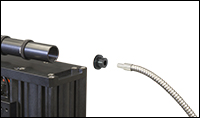 Click to Enlarge
Click to EnlargeアダプタAD8Fを落射照明モジュールWFA2001にねじ込みます。
 Click to Enlarge
Click to EnlargeAD8Fの止めネジ(1.5 mm六角レンチ)でファイバーバンドルを固定します。
透過照明モジュールへの取付け
透過照明モジュールWFA1000およびWFA1100で均一な照明を得るには、30 mmケージシステムに固定されたビーム径がØ25.4 mm(Ø1インチ)のコリメート光源が必要です。そのため、OSL2からの出射光を焦点距離60.0 mmの平凸レンズを用いてコリメートする必要があります。当社では、N-BK7平凸レンズLA1134またはLA1134-Aのご使用をお勧めしています。 LA1134にはコーティングが有りませんが、OSL2のスペクトル全域において比較的均一な透過率を示します。これに対してLA1134-AにはARコーティングが施されており、350~700 nmの波長範囲における透過率は改善されますが、700 nmを超えると透過率は低下します。詳細については「光学コーティング」のページをご覧ください。焦点距離がわずかに長いレンズをお使いいただくこともできますが、その場合、試料面の照明は暗くなります。
OSL2用のケージシステムを組み立てるには、まず付属の固定リング(型番SM1RR)でレンズをSM1ネジ付きの30 mmケージプレート(型番CP33/M)に取り付けます。次に、もう1つのケージプレートにØ8 mm-SM1アダプタ(型番AD8F)を固定します。アダプタの位置を固定するには追加の固定リングをご利用ください。そして、透過照明モジュールの側面にあるダストカバーを1.5 mm六角レンチで取り外し、ケージロッド(型番ER3-P4)を取り付けます。その後、側面に露出している#4-40ロック用止めネジでケージロッドの位置を固定します(0.05インチ六角レンチ使用)。ケージロッドを固定したら、レンズを取り付けたケージプレートを、レンズの凸面が透過照明モジュール側になるようにしてロッド上をスライドさせます。その後、アダプタAD8Fを付けたケージプレートを取り付けます。さらに、ケージプレートを側面の#4-40ロック用止めネジでケージロッドに固定します。アセンブリが固定されたら、#6-32止めネジ(セットスクリュ)でファイバーバンドルの端をコリメーターパッケージの端に取り付けます(1.5 mm六角レンチ使用)。下の図と写真でこの組立て手順をご覧いただけます。
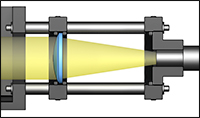 Click to Enlarge
Click to EnlargeOSL2のコリメート
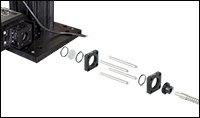 Click to Enlarge
Click to Enlargeコリメートに必要なケージシステム部品
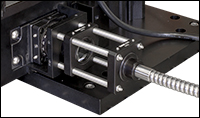 Click to Enlarge
Click to Enlargeケージアセンブリを側面の#4-40ロック用止めネジで透過照明モジュールに固定します。
2つのケージプレートは、ファイバ端とレンズの平坦面の間の距離が56.7 mm(レンズの後方焦点距離)となるように離して設置してください。ケージシステムを使用すると、アライメントを保持したままケージプレート間の距離を簡単に調整できます。取付けに関してご不明な点がありましたら、当社までご連絡ください。
| Posted Comments: | |
Lawal Adebayo
(posted 2023-09-26 15:42:08.65) Hi,
My name is Adebayo Lawal a Phd candidate at Case Western Reserve University. We have the OSL1 - High Intensity Fiber Light Source in our lab, however the product seems to be faulty.
The product powers on and the fan runs (one can verify by the sound it makes and by touching the device) but the bulb doesn't lit up.
Kindly advice on what can be done to fix this problem.
Thanks and best regards,
Lawal ksosnowski
(posted 2023-09-26 05:27:01.0) Hello Lawal, thanks for reaching out to Thorlabs, and sorry to hear of your issues with the OSL1 lamp. Though we no longer produce the full OSL1 lamp fixture we do still offer a replacement bulb for this as our part# OSL1B. If you notice a lack of electrical continuity in your current bulb then it may be worn out in which case a replacement should restore performance. I have reached out directly to discuss this further. María Castro Fernández
(posted 2023-05-11 15:07:13.35) Hello! I plan to use the OSL2BIR light source to obtain spectral signatures within the visible and near-infrared wavelength range. However, I see in the documentation of the FRI61F50 ring illuminator that its fiber bundle maximum operating wavelength is 900nm. Is it possible to operate in the near-infrared range effectively (until 1100nm at least)? Considering the 46% transmission of the ring illuminator, how much power should I expect to obtain, both in the visible and near-infrared ranges? ksosnowski
(posted 2023-05-16 01:42:26.0) Thank you for contacting Thorlabs. The transmission of FRI61F50 beyond 900nm is very low, so we do not recommend it for near-infrared application beyond 900nm. For using the FRI61F50 with OSL2, the total output will be similar to what can be achieved with a OSL2FB. Lionel Rudaz
(posted 2022-06-23 13:26:23.71) Hello,
I wanted to know if coupling this light source into a single mode fiber was possible ? cdolbashian
(posted 2022-06-24 04:06:18.0) Thanks for contacting Thorlabs. Unfortunately, since this cannot be considered a point source (and is highly divergent), the coupling efficiency into a few um core size single mode fiber is going to be very low ( <<1%). This comes from the restriction driven by the optical invariant, also known as etendue. user
(posted 2022-05-17 23:24:51.143) Following this sentence: "We recommend verifying that any other fiber bundle used with the OSL2 or OSL2IR light sources can sustain the heat from the bulb; please contact Tech Support with inquires." - Can one couple the OSL2 illuminator output into a multimode fiber patch cable (such as the 105um core, .22 NA M43L01 cable for example) using the suggested SM1FC2 adapter? Or are there other, more preferable solutions for this? Thanks jgreschler
(posted 2022-05-21 10:03:23.0) Thank you for reaching out to Thorlabs. In the specs tab of the OSL2 lamp page in footnote c it notes that the combined operating temperature of the lamp and the fiber bundle is 0-40C, the fiber patch cable you have indicated has a temperature range of up to 85C so this will be fine. Jintao Kong
(posted 2020-06-13 17:04:21.62) Can you provide Y-type boudle with core diameter like OSL2FB and shape like BF19Y2LS02? YLohia
(posted 2020-06-15 10:12:48.0) Thank you for contacting Thorlabs. We offer the OSL2YFB, which is the Y-shaped bundle similar to the OSL2FB. Custom items can be requested by emailing your local Thorlabs Tech Support team (in your case, europe@thorlabs.com). We will contact you directly regarding this. user
(posted 2019-12-25 16:19:06.103) by using the OSL2COL, is the beam from the fiber bundle perfectly collimated for microscopy or only roughly collimated. nbayconich
(posted 2019-12-30 09:44:20.0) Thank you for contacting Thorlabs. The OSL2COL includes a LA1289 lens which provides a rough collimation for the OSL2 source. The half angle of the beam will be between 5~8 degrees Tom Baker
(posted 2019-05-15 20:46:42.647) What is the M60/1 threading compatible with - I can't seem to find any adapters on the adapters page in that size. What filter mounts/sets will work? llamb
(posted 2019-05-23 04:25:05.0) Thank you for your feedback. We do not currently have any M60 x 1.0 thread adapters available in our catalog unfortunately. This idea has been noted in our internal product forum for further review. marcin.bartosik
(posted 2018-08-10 14:21:07.573) Hello!
Please let me know if i could buy the OSL2 without the Fiber Bundle (I would by only an SMA adapter)?
Have a nice day,
Marcin YLohia
(posted 2018-08-10 10:08:00.0) Hello Marcin, thank you for contacting Thorlabs. We can offer this item without the fiber. Quotes for customized items can be requested at techsupport@thorlabs.com. ms293
(posted 2018-02-15 14:42:58.697) Hello
I want to mount the OSL2YFB into a cage system and was wondering which adapter is used to couple the OSL2YFB to the OSL2?
Cheers. YLohia
(posted 2018-03-31 02:05:51.0) Hello, thank you for contacting Thorlabs. We currently use a version of the AD8F adapter to mount the OSL2 fiber bundles. You can use this with any internally SM1-threaded optomechanical component, including the CP02 cage plate. pgutierr
(posted 2015-11-10 17:16:39.737) Dear ThorLabs,
How does the variable intensity control work for the OSL2?
By physically blocking the light or dimming the halogen lamp?
Best
Pablo Gutierrez
Electronic Engineering Dpt.
European Southern Observatory
Karl-Schwarzschild-Str. 2
85748 Garching, Germany jlow
(posted 2015-11-16 02:07:40.0) Response from Jeremy at Thorlabs: The variable intensity control works by dimming the halogen lamp. littlefox121
(posted 2013-08-16 17:38:58.977) What is the approximate output power if 150W light source is output coupled by fiber bundle? tcohen
(posted 2013-08-29 16:08:00.0) Response from Tim at Thorlabs: Although these values can vary, the supplied fiber bundle will be ~500mW. A 7 fiber, 550um core, .22NA would be ~150mW. Single fibers will be less. For example, 1000um, .39NA would be ~80mW. tcohen
(posted 2012-08-21 13:44:00.0) Response from Tim at Thorlabs: The output of this source is very high intensity and divergent. If prepared for the losses one will have during coupling, this can be done with aspheric condenser lenses or achromats. A general setup is provided below by Javier. As an alternative, we offer the OSL1-SMA which can directly mate the OSL1 to an SMA 905 connectorized fiber bundle. I will contact you directly to go over these options with you. czl0579
(posted 2012-08-20 12:52:57.0) Do you have some suggestions that how to couple this light source into a multimode fiber (M14L02)? We lost the original fiber bundle and now use a light guide instead. Also, do you have some suggestions to couple the source to it? Thanks. anqi.zhang
(posted 2012-08-17 10:00:00.0) Any suggestion regarding how to couple this light source into a 50 micron core fiber? tcohen
(posted 2012-04-16 10:39:00.0) Response from Tim at Thorlabs: Thank you for your feedback! We are constantly looking for ways to improve our products and I will discuss your suggestion with our production team. user
(posted 2012-04-12 15:47:27.0) would be cool if there was an inexpensive way to control this remotely. Only other option I can find is your $2k high power source. lmorgus
(posted 2011-03-31 14:41:00.0) Response from Laurie at Thorlabs to the anonymous poster: Thank you for taking the time to let us know that one of our links is broken. We will fixed it right away and apologize for the inconvenience. user
(posted 2011-03-31 13:58:58.0) Catalog page PDF download link for the OSL1 is broken Thorlabs
(posted 2010-11-08 17:48:28.0) Response from Javier at Thorlabs to last poster: we are currently gathering this information for you. Please contact us at techsupport@thorlabs.com so that we can can keep you updated on this request. user
(posted 2010-11-08 12:29:06.0) Is it possible to label the spectral density of the plot on the overview tab with units of uW/nm, as is done for the HPLS-30-04? Thorlabs
(posted 2010-09-10 15:45:00.0) Response from Javier at Thorlabs to yuj210: I will contact you shortly. yuj210
(posted 2010-09-09 13:53:14.0) Dear Javier, would you reply my following inquiries ASAP? I sent mails, left voice message also. Thanks. Thorlabs
(posted 2010-09-08 19:10:19.0) Response from Javier at Thorlabs to yuj210: Regarding the OSL1, the output from the fiber is very divergent (NA in the range of 0.5-0.6), so it is very difficult to achieve a well collimated output. In order to collect the output from the fiber tip, I would recommend using one of our aspheric condenser lenses. A good candidate is the ACL5040:
http://www.thorlabs.com/NewGroupPage9.cfm?ObjectGroup_ID=3835
This lens has a diameter of 50 mm, a focal length of 40 mm, and a numerical aperture of 0.55. This lens can be mounted onto the LMR2 mount: http://www.thorlabs.com/NewGroupPage9.cfm?ObjectGroup_ID=1433&pn=LMR2
Now, in order to focus the output from the OSL1 into multimode fiber, you will most likely need to reduce the size of the beam. A 20X beam expander used as a reducer may be suitable:
http://www.thorlabs.com/NewGroupPage9.cfm?ObjectGroup_ID=1580
I will contact you directly to discuss the details of your application, including the fiber specifications. yuj210
(posted 2010-09-08 00:56:30.0) Im planning an experiment using this OSL1. Let me ask something. If I dont care money much, what would be the best choice to get collimated beam with OSL1. Im thinking of chromatic lens, AC127-019-A-ML . I need your comment and recommend also. Thanks. Thorlabs
(posted 2010-08-06 11:45:02.0) Response from Javier at Thorlabs to last poster: Thank you for your feedback. We have added the light output spec in lux. user
(posted 2010-08-06 11:11:35.0) Who uses "foot candles" these days, try to make to the modern world Adam
(posted 2010-05-12 16:10:04.0) A response from Adam at Thorlabs to dellapir: We took one from stock and measured the power. The minimum power is 50mW and the maximum power is 1.8W. The change in the power is exponetial as you rotate the potentiometer. dellapir
(posted 2010-05-12 12:46:23.0) Mr./Mrs:
We´ve bought your OSL1-EC lamp with optical fiber. As you know it is possible to change the intensity of the lamp, and this is the information that we need.
Can you tell us what the minimum and maximum intensity emitted by the lamp? The change , which is possible using the potentiometer marked on the lamp, is a linear or exponential?
Thank you!!!
Best regards.
Monica Della Pirriera
MNT group
Univeridad Poltecnica de Cataluña apalmentieri
(posted 2009-12-18 11:37:15.0) A response from Adam at Thorlabs: I would like to discuss this further with you. I will send you an email to try and find out the exact parameters that you are looking for. juanpamunoz
(posted 2009-12-18 09:23:20.0) Hi, i´m using your lamp in the "Opto Electronic Lab of UNIVERSIDAD DE CONCEPCION, CHILE", and i would like to know more specifications about the "High-Intensity Fiber Light Source OSL1-EC", like SNR coefficient and another kind of parameters.
Thus, i could add more accuracy to my thesis measurements.
Thanks a lot.
Juan Pablo Muñoz Carmona.
Thesis Student.
Civil Engineering Electronics.
Universidad de Concepción. jens
(posted 2009-06-09 08:12:28.0) A reply from Jens at Thorlabs: coupling of this 150W light source into a single mode fiber is virtually impossible. We might be able to offer a different solution if we get additional information regarding your setup. I will contact you directly for that. user
(posted 2009-06-09 04:21:03.0) what adapter do i use to couple the SMF(core 9um)? jens
(posted 2009-05-18 17:45:55.0) An answer from Jens at Thorlabs: the output power at 1100nm is virtually zero. We probably can offer a custom solution where we would replace the light bulb inside the unit. We will contact you with a quotation directly. As for the collimation you could try using a pinhole but if you need better collimation since you may want to guide the light over a longer distance a plano-concave singlet lens such as our BK7 lens LA1540 can be used. The lens will need to be place 15mm in front of the output. The output fiber bundle can be hold in place using our AD12F adapter. Using that adapter the fiber end can be mounted in a cage system using cage plate CP02. We will contact you directly as soon as possible. nutik
(posted 2009-05-18 16:55:54.0) Do you have any accessories for this light source to have a parallel output beam or a focused beam?
What is the intensity of the output light at 1100nm? Tyler
(posted 2008-08-14 10:54:17.0) A response from Tyler at Thorlabs to sai: The blackbody radiation equation shown on the specs tab is really only intended to give the user of an OSL1 an idea of the spectral distribution of the light emitted from the halogen lamp. In reality, the lamp is not a perfect blackbody source and certainly the glass bulb and MM fiber bundle will have some absorption profile that will modify the emitted intensity versus wavelength even further from an ideal blackbody source. sai
(posted 2008-08-04 11:03:38.0) I have a question regarding the formula you have used to calculate the intensity in the "specs" tab. Will this give me power density (Watts per cubic meter)? If yes, can you please tell me how to find the intensity in terms of Power/ Surface area (Watts per sq meter)? Thanks! Tyler
(posted 2008-08-01 13:58:59.0) A response from Tyler at Thorlabs to smitachat2001: Thank you for your interest in the OSL1. There is no specific reason why the OSL1 halogen lamp cannot be left on continuously. The housing will get quite warm over time but if the unit is in a room temperature environment and the airflow to the cooling fan is not blocked the lamp will function properly. The one drawback to using the lamp continuously is that the hotter the lamp is the shorter its lifetime so for continuous use it might be wise to improve the cooling of the lamp. smitachat2001
(posted 2008-07-30 21:20:50.0) It is certainly usefull product but it looks as if they are not meant to be used for 24 hours, which makes them restricted for many lab purposes. Tyler
(posted 2008-06-26 16:29:35.0) A response from Tyler at Thorlabs to leosis: I have added a plot of the theoretical emission intensity as a function of wavelength to the "Specs" tab. The light will appear white, but as you can see from the plot, the emission intensity will peak near 910 nm when the unit is at maximum power. leosis
(posted 2008-06-23 07:20:25.0) i want to know the operating wavelengt of this product.
please, reply to me about this information. Tyler
(posted 2008-06-05 12:16:30.0) A response from Tyler at Thorlabs: The divergence angle of the fiber bundle is not a controlled specification and as a result cannot be guaranteed. However, I tested a OSL1 and measured a divergence angle of 33 degrees (This was determined by measuring the spot diameter at several distances from the fiber bundle tip and fitting the data to a straight line. The inverse tangent of the slope of the fit line was 33 degrees.) user
(posted 2008-06-05 10:13:02.0) Whats the divergence angle of the fiber bundle at the output tip? |
下記は、当社のすべての白色広帯域照明用光源(ランプ)のセレクションガイドです。これらの光源以外に、マウント無し白色LEDやマウント付き白色LED、ファイバ出力型白色LED、Solis®高出力白色LEDもございます。
| Broadband Light Source Selection Guide | ||||||||||
|---|---|---|---|---|---|---|---|---|---|---|
| Item # | (Click to Enlarge; Not to Scale) | Emitter Type | Wavelength Range (Click for Plot) | Output Coupling | Output Power | Lamp Electrical Power | Color Temperature | Lamp Lifetime | Replacement Lamp | |
| SLS204 | Deuterium | 200 - 700 nm | Free Space or Fiber Coupled (SMA) | 2 mWa 0.1 mWb (Typ.) | 30 W | N/A | 2000 hc | SLS254B | ||
| SLS205 | Xenon Arc | 240 - 1200 nm | Free Space or Fiber Coupled (SMA) | 290 mWa 5 mWd (Typ.) | 75 W | 5800 Ka 5400 Kd | 2000 hc | SLS255B | ||
| SLS401 | Xenon Arc | 240 - 2400 nm | Free Spacee | >1.3 Wa | 150 W | 5800 K | 2000 hc | SLS401Bf or SLS402B | ||
| SLS402 | Mercury-Xenon Arc | 240 - 2400 nm | Free Spacee | >1.3 Wa | 150 W | 6000 K | 2000 hc | SLS401B or SLS402Bf | ||
| SLS302 | Quartz Tungsten-Halogen | 360 - 2500 nm | Free Spacee | >10 Wa | 150 W | 3400 K | 1000 hg | SLS301B | ||
| SLS201L(/M) | Quartz Tungsten-Halogen | 360 - 2600 nm | Free Spacee or Fiber Coupled (SMA) | 500 mWa 10 mWh | 9 W | 2796 K | 10 000 h | SLS251 | ||
| SLS301 | Quartz Tungsten-Halogen | 360 - 3800 nm | Free Spacee | >1.6 Wa | 150 W | 3400 K | 1000 hg | SLS301B | ||
| SLS603 | Xenon Arc | 380 - 780 nm | Ø3 mm Liquid Light Guide | >7 Wh | 300 W | 6000 Ki | 1000 hc | SLS600B | ||
| SLS605 | Xenon Arc | 380 - 780 nm | Ø5 mm Liquid Light Guide | >15 Wh | 300 W | 6000 Ki | 1000 hc | SLS600B | ||
| OSL2 | Tungsten-Halogen | 400 - 1600 nm (Typical) | Fiber Bundle | 1.4 Wk | 150 W | 3200 K | 1000 hc | OSL2Bf, OSL2B2, or OSL2BIR | ||
| OSL2IR | Tungsten-Halogen | 400 - 1750 nm (Typical) | Fiber Bundle | 3.8 Wk | 150 W | 3200 K | 200 hc | OSL2B, OSL2B2, or OSL2BIRf | ||
| QTH10(/M) | Quartz Tungsten-Halogen | 400 - 2200 nm | Free Space | 50 mW (Typ.) | 10 W | 2800 Kl (Typ.) | 2000 h | QTH10B | ||
| SLS203F(/M) | Silicon Carbide Globar | 500 nm - 9 µm | Free Spacee or Fiber Coupled (SMA) | 1.8 Wa | 24 W | 1500 K | 10 000 h | SLS253 | ||
| SLS303 | Silicon Nitride Globar | 550 nm - 15 µm | Free Space | 4.5 Wa | 70 W | 1200 K | 5000 hg | SLS303B | ||

- 150 W、3200 Kのハロゲンバルブ
- OSL2:ほとんどの赤外域光をブロックするホットミラーとライトバルブOSL2Bが内蔵
- OSL2IR:赤外域での出力を強化するアルミニウムコーティング付きリフレクタとライトバルブOSL2BIRが内蔵
- 前面パネルのノブにより出力パワーを連続可変
- 長さ91 cmのファイバーバンドルが付いたSM1内ネジ付き出力ポート
当社の高強度ファイバ出力光源は、明視野顕微鏡や一般的な照明の用途向けに設計されています。各光源には、取外し可能な長さ91 cm、コア径Ø6.4 mmのファイバーバンドルが付属しています。交換用のファイバーバンドルもご用意しています(別売り、下記参照)。また、各光源には、オプトメカニクスのセットアップを組み込めるようSM1内ネジが付いた出力ポートが付いています。
光源には、過熱に対してユニットを保護する機構と、アクセスドアが開いたときにランプの電源を遮断する機構が内蔵されています。前面パネルのLED表示は、正常に動作しているときは緑色になっています。ユニットが過熱したときには、ランプへの電力供給が遮断され、LED表示は赤色になります。通常の動作中にアクセスドアが開いたときには、ランプとLEDへの電力供給が遮断されます。
OSL2にはライトバルブOSL2Bが予め取り付けられており、ほとんどの赤外域光をブロックするホットミラーが内蔵されています。出力波長範囲(典型値)は400~1600 nmです。OSL2BIRにはライトバルブOSL2BIRが予め取り付けられております。ホットミラーではなく、アルミニウムコーティング付きのリフレクタを用いることにより近赤外域での出力が強化されています。出力波長範囲(典型値)は400~1750 nmです。詳細については「仕様」のタブをご覧ください。
OSL2およびOSL2IRは電源が内蔵しております(汎用のAC電源入力で動作します)。また、交換用ライトバルブもご用意しています。詳細は下記をご参照ください。OSL2またはOSL2IRを付属のファイバーバンドル無しでご注文の場合など、カスタムオーダについては当社までお問い合わせください。

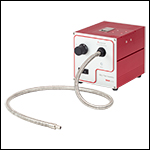
Click to Enlarge
テーブル上にフラットに置いたバンドルOSL2FB
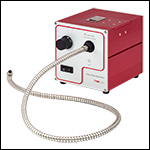
Click to Enlarge
上向きに角度をつけたグースネック付きバンドルOSL2RFB
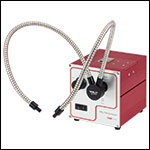
Click to Enlarge
2つのビーム位置を独立に固定できるグースネック付きY分岐型バンドルOSL2YFB
- ファイバ光源OSL2とOSL2IRの交換用ファイバーバンドル
- グースネック付きバンドル:剛性が増し、手動位置決めが容易
- Y分岐型バンドル:ビームを2つの独立した位置に固定可能
- 旧光源OSL1にも対応可能
当社では上記のファイバ光源OSL2とOSL2IR用に設計されたファイバーバンドルをご用意しております。これらのケーブルのファイバ端の外径はØ7.9 mmで、OSL2ならびにOSL2IRに付属するファイバーバンドルの交換品としてご使用になれます。
単一出力ファイバーバンドル
単一出力のファイバーバンドルOSL2FBは、フレキシブルなステンレススチール製の筐体に納められており、光源OSL2およびOSL2IRに付属するバンドルの代替品としてご使用になれます。
グースネック型単一出力ファイバーバンドル
OSL2RFBは光源OSL2およびOSL2IRに付属するバンドルと同じファイバ構造ですが、安定で手動での位置決めが容易に行えるグースネック型になっています。グースネック型の被覆は、バンドルの位置を設定するとそれを保持することが可能です。
グースネック型Y分岐バンドル
OSL2YFBは、ファイバ光源より出力された光を2つのビームに分割し、それぞれが独立に位置決め可能なため広い作業面を照らすことができます。OSL2およびOSL2IRに付属するファイバーバンドルとは異なり、2分岐した各アームは手で簡単に位置決めができるグースネック型となっています。
| Item # | OSL2FB | OSL2RFB | OSL2YFB |
|---|---|---|---|
| Description | Single-Output Bundle | Gooseneck Single-Output Bundle | Gooseneck Y-Bundle |
| Fiber Bundle Length | 91 cm (36") | 91 cm (36") | 51.69 cm (20.35") |
| Bundle Effective Core Diametera | 6.4 mm (0.25") | 6.4 mm (0.25") | 4.52 mm (0.18") |
| Operating Wavelength Rangeb | 390 - 1750 nm | ||
| Numerical Aperture (NA) | 0.57 | ||
| Number of Fibers (Input) | 6718 (Calculated) | ||
| Fiber Core Diameterc | 50 µm | ||
| Fiber Cladding Diameterc | 52.5 µm | ||
| Fiber Material | Silica | ||
| Fiber Strength | > 150 kg/mm2 | ||
| Attenuation (at 940 nm) | < 0.6 dB/m | ||
| Minimum Bend Radius | 100 mm | 100 mm | 150 mm |
| Operating Temperature | 0 to 180 °C | 0 to 135 °C | 0 to 135 °C |

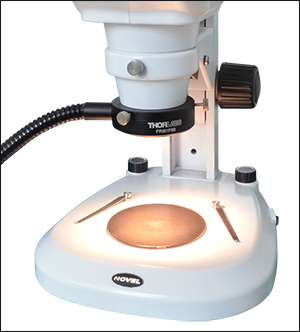
Click to Enlarge
ズーム顕微鏡に取付けられたFRI61F50
- 大きな作動距離の範囲: 50~170 mm
- 高照度で均一な360°シャドウフリー(影のない)の照射エリアを実現
- 顕微鏡の光軸に沿った照明
ファイバーリングイルミネータFRI61F50には、長さ915 mmのファイバーバンドルが付属します。そのファイバーバンドルで、当社のファイバ出力光源OSL2またはOSL2IRからの光を、同心円状の5本のファイバーリングで構成されたØ55 mmのリングイルミネータに結合します。このイルミネータは、右の写真のように、多くの標準的な正立顕微鏡に簡単に取付けることができます。3本のつまみネジで取付けますが、それらの先端はナイロン製になっているため、保持するのに十分な摩擦力を有する一方で、顕微鏡を傷付けることもありません。ファイバーリングは、直径60 mm以下の対物レンズ用筐体に取付けられます。
このリングイルミネータは、ほぼ顕微鏡の光軸に沿って光を照射するようにアライメントされており、作動距離(WD)の範囲において試料面をシャドウフリーで均一に照明することができます。5つのファイバーリングを使用することで、1つのファイバーリングよりも照明の強度や作動距離の範囲が増大しています。
ファイバーリングイルミネータをOSL2またはOSL2IRに接続するためのアダプタが付属しています。アダプタに付いている先端がナイロン製の2本の止めネジ(セットスクリュ)は、付属の1/16"六角レンチで締めることができます。その代替品としては、アダプタAD16Fをご使用いただけます。
FRI61F50の作動距離の範囲は50~170 mmです。イルミネータを170 mmを超える距離で使用した場合、照明強度は低下しますが均一性は保たれます。この状態でも、用途によっては許容できる場合があります。
下記の表内にある青いInfoアイコン![]() をクリックすると、仕様、性能データ、および図面をご覧いただけます。
をクリックすると、仕様、性能データ、および図面をご覧いただけます。

| Item # | OSL2COL | OSL2FOC |
|---|---|---|
| Description | Collimation Package | Focusing Package |
| Working Distance (WD) | N/A | 20 mm |
| Outer Dimensions | Ø17.8 mm x 47.3 mm | Ø17.8 mm x 56.0 mm |
| Threads on Output Port | Internal SM05 (0.535"-40) Threads | |
| Installed Lenses | LA1289 (1 Place) | LA1289 (2 Places) |
| Spot Size at 20 mm Working Distance | Ø14.5 mm | Ø5.5 mm |
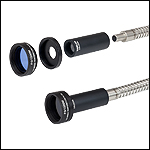
Click for Details
Ø25 mmフィルタを取り付けたコリメーターパッケージOSL2COL
- 光のコリメートまたは集光用パッケージ
- 光源OSL2、OSL2IRならびに旧光源OSL1に適応する設計
- 出力端はSM05内ネジ付きで当社のØ12 mm~Ø12.7 mm(Ø1/2インチ)レンズチューブに対応
- 外径は当社のØ12 mm~Ø12.7 mm(Ø1/2インチ)レンズチューブと同じØ17.8 mm
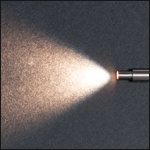
Click for Details
光学素子無しのファイバーバンドル
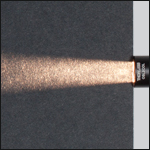
Click for Details
コリメーターパッケージOSL2COL
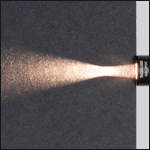
Click for Details
集光用パッケージOSL2FOC
こちらのコリメートまたは集光用パッケージは、光源OSL2、OSL2IRならびに旧光源OSL1に付属するファイバーバンドル、また上記掲載のファイバーバンドルの代用品にも適応する設計となっております。1.6 mm(1/16インチ)六角レンチに対応する止めネジ(セットスクリュ)2本により、ファイバーバンドルの先端を、コリメートまたは集光用パッケージの後部に固定します。 各パッケージ前面にあるSM05内ネジと外径サイズ(17.8 mm)により、当社のØ12 mm~Ø12.7 mm(Ø1/2インチ)レンズチューブや機構部品に直接取り付けることが可能です。
左の写真はOSL2に付属するファイバーバンドルから出力された光です。左端の写真は、レンズアセンブリが取り付けられていない状態のファイバーバンドルの端から光が広発散角に出力されていることを示しています。 真ん中の写真ではコリメーターパッケージ、1番右の写真では集光用パッケージが取り付けられています。
右端の写真はマウント付きのØ25 mmフィルタを使って、OSL2からの出力光にフィルタをかける1つの方法を示しています。マウントなしのØ12.5 mmやØ25 mmフィルタを使った他の組み合わせについては、写真をクリックして詳細をご覧ください。

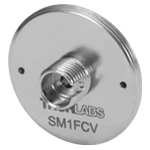
Click for Details
真空対応のワイドキー付きFC/PCアダプタ
- FC/PCまたはSMAバルクヘッド付きSM1ネジディスク
- FC/PC(ワイドキー)とSMAレセプタクルは真空対応の製品もご用意
- 標準的なファイバーパッチケーブルまたはファイバーバンドルを光源OSL2およびOSL2IRに接続
当社のファイバーコネクタ用アダプタは、ファイバーパッチケーブルや標準的なコネクタ付きのファイバーバンドルを光源OSL2およびOSL2IRに接続する際に用います(右写真参照)。SM1FCとSM1SMAには真空対応製品もご用意しております。SM1SMAVとSM1FCVアダプタはどちらも10-10 Torrまでの真空に対応します。なおファイバーパッチケーブルならびにファイバーバンドルは、OSL2やOSL2IRに付属するファイバーバンドルよりもコア径または有効コア径が小さく、そしてNAが低いため、光の出力が低くなりますのでご注意ください。ほかのファイバーバンドルを光源OSL2またはOSL2IRとご使用になる場合は、バルブからの熱に耐えられることを事前にご確認いただくことをお勧めします。ご質問は当社までお問い合わせください。
パッチケーブルを接続する際、まずOSL2またはOSL2IRに予め付いているファイバーバンドル用アダプタのネジを緩め、出力ポートから取り外します。 その後ファイバーコネクタ用アダプタを出力ポートにねじ込んでください。各ディスクには前面に2つと背面に2つ、計4つの窪みがあり、スパナレンチSPW909またはSPW801を使用してディスクを締め付けることができます。このアダプタを遮光用途でお使いいただけるように、窪みはディスクを貫通していません。当社のSM1ネジ付きアダプタについては、光ファイバーアダプタのページをご覧ください。

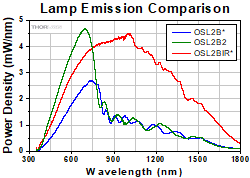
Click to Enlarge
生データはこちら
交換用ライトバルブの比較。これらのスペクトルは付属のファイバーバンドルを用いて取得されており、ファイバーバンドル内の減衰の影響も含まれています。
*OSL2Bは光源OSL2に付属
**OSL2BIRは光源OSL2IRに付属
- OSL2B:光源OSL2に付属する3200 Kライトバルブの交換用バルブ
- OSL2B2:OSL2Bよりも高出力の3400 Kバルブ(下のグラフ参照)
- OSL2BIR:光源OSL2IRに付属する3200 K、近赤外域出力が強化されているライトバルブ(交換用)
- 旧光源OSL1の交換用バルブは下でご紹介
高強度ファイバ光源OSL2およびOSL2IRの交換用バルブを3種類ご用意しております。 OSL2BはOSL2に付属するバルブと同一製品で、OSL2B2は高出力型になります。OSL2BIRはOSL2IRに付属するバルブと同一のものです。ライトバルブOSL2BならびにOSL2B2には、ほとんどの赤外域光をブロックするホットミラーが組み込まれています。対してOSL2BIRは、アルミニウムコーティングの反射鏡を用いていて、前述のホットミラーは組み込まれていないため、近赤外域において大きな光量が得られます。下のグラフでは、これらのバルブのスペクトルと相対出力を比較しています。スペクトルおよび生データをご覧になるには下の表にあるグラフのアイコンをクリックしてください。
交換用バルブを光源OSL2またはOSL2IRに取り付ける際には、右上の写真の通りユニット上面の蓋を開け、古いライトバルブを取り外します。 詳細はOSL2またはOSL2IRのマニュアルのChapter 5をご覧ください。

交換用ライトバルブOSL1Bは当社の旧光源OSL1に付属するライトバルブと同一製品です。このバルブにはホットミラーが内蔵されていて、ほとんどの赤外域光をブロックします。右表内のグラフのアイコンをクリックすると、バルブの出力スペクトルをご覧いただけます。
旧光源OSL1に取り付ける際には、ユニット前面にある2つの留め具を緩め、ライトバルブのアセンブリをスライドさせて取り出し、古いライトバルブを外します。詳細はこちらのPDF形式のOSL1のマニュアルのChapter 4をご覧ください。ライトバルブOSL1Bは光源OSL2またはOSL2IRにも取り付けることができます。交換方法は、OSL2またはOSL2IRのマニュアルのChapter 5をご覧ください。

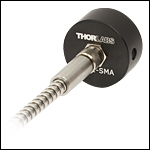
Click to Enlarge
アダプタOSL1-SMAに取り付けたSMAファイバーバンドル
ファイバーバンドル用アダプタOSL1-SMAは、SMAコネクタ付きのマルチモードファイバーバンドルを旧ファイバ光源OSL1の出力に使用する際に用います。 SMAコネクタ付きのファイバーバンドルは、旧光源OSL1に付属するファイバーバンドルならびにY分岐ファイバーバンドルOSL2YFBに比べて、より広い動作波長範囲を有し、より長いファイバ長の製品をご提供可能です。
アダプタOSL1-SMAは、旧ユニットOSL1の前面パネルに挿入し、つまみネジで固定します。 SMA905ならびにSMA906型のコネクタにも対応可能です。
注:OSL1-SMAは現行の光源OSL2またはOSL2IRにはお使いいただけません。
 Products Home
Products Home


















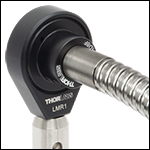
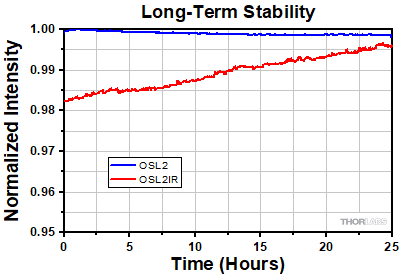
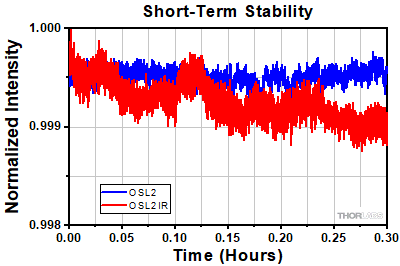
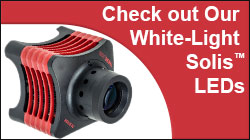
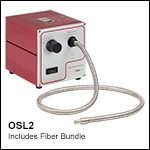
 ズーム
ズーム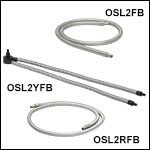
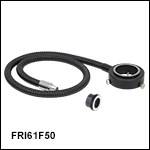
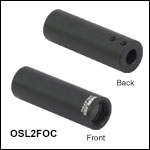
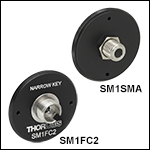
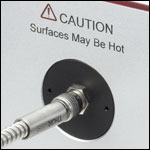
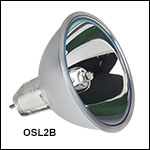
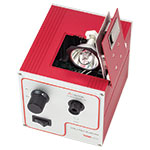
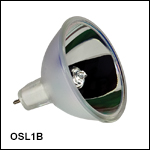
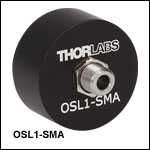
 ファイバ出力タングステンハロゲンランプ光源
ファイバ出力タングステンハロゲンランプ光源